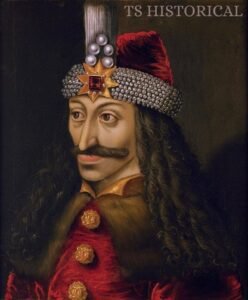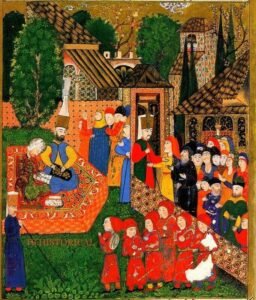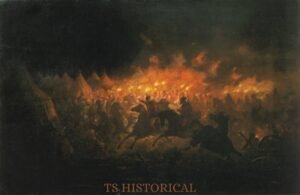Table of Content
Vlad the Impaler (Dracula)
In 1431, more than four hundred years before Bram Stoker published his famous Dracula, a chubby baby boy born in Transylvania would be affectionately named Vlad III Dracula. Unbeknownst to anyone at the time, Vlad the Impaler would grow up to inspire a story about a legendary blood-sucking vampire. Although Vlad’s family hailed from Transylvania, the region today is Romania.
In the medieval era, the Romanian royals didn’t go for family loyalty, and Vlad’s family secured allegiance elsewhere. Vlad’s dad was Vlad II, one of many illegitimate sons of Mircea I of Wallachia. As such, he didn’t have much intention or chance of ruling the region even though illegitimate heirs were still allowed to rule. When Sigismund of Luxembourg, the King of Hungary, decided to found a Chivalric Order – called the Order of the Dragon – one of his recruits was the young prince Vlad the Impaler.
This move proved beneficial for Vlad, as the Order of the Dragon supported instating him as king following the murder of his father and half-brothers at the hands of Wallachian boyars (nobles). This move helped him gain power over Transylvania. As a tribute to the Order, Vlad’s family would henceforth be known as Dracula, meaning Son of Dracul; Son of the Dragon.
Facts about Vlad the Impaler

| Born: | 1428–1431 |
| Died: | December 1476 – January 1477 (aged 45 – 49) |
| Spouse: | Unknown first wife, Jusztina Szilágyi |
| Parents: | Vlad II of Wallachia (Father), Eupraxia of Moldavia (Mother) |
| Issue: | Mihnea |
| House: | Drăculești, House of Basarab |
| Religion: | Eastern Orthodox, Disputed Roman Catholic |
Christianity in the Ottoman Empire

Vlad III was five, his father began to rule Wallachia, and the family moved there. The Order of the Dragon was distinctly Christian, which put Wallachia in conflict with the rising Islamic Caliphate of the Ottoman Empire. In 1442, Vlad the Impaler and his younger brother, Radu, were sent to the Ottoman Sultan Murad II court. However, they were more like hostages than guests and stayed as insurance that Vlad II would support Ottoman policies. The throne of Wallachia was heavily contested, and Vlad II sent his sons voluntarily in exchange for the Ottoman’s support of his rule.
Download this Article in PDF Format
Get a well-documented version of this article for offline reading or archiving.
Download Now (1.16 MB)However, there is some dispute about how Vlad the Impaler and Radu ended up in the court of the Sultan. Some historians state that Vlad II had traveled to Gallipoli after refusing to support the Ottoman invasion of Transylvania and that Vlad II had been imprisoned with his sons but was released a year later. Whatever the exact circumstance, Vlad and Radu were left with the Sultan, and Vlad II promised the Ottomans a yearly tribute and a supply of young men for their army.
Mircea II of Wallachia
The eldest son of Vlad II was Mircea II, and while he was close with his father, he disagreed with his policies regarding the Ottomans. Mircea II led Wallachian forces against the Ottomans and successfully recaptured a fortress that his father subsequently made him give back. These circumstances meant that Vlad II had proved to be a fickle ally to the Order of the Dragon.
He had not supported the Christians in their war against the Ottomans, and the extenuating circumstances of his son’s detention were not considered. After a disastrous Christian defeat in the Battle of Varna, resentment soon grew amongst the Wallachian nobles, who revolted in 1447, tortured Mircea, and buried him alive. Vlad II also died that same year. Still, in the Sultan’s court, Vlad III would not hear of the deaths until his return to Wallachia in 1448 at the age of seventeen. His time with the Ottomans had not been all bad. He had been tutored in art, philosophy, and science, as well as horsemanship and combat.
Radu the Handsome
The eldest son of Vlad II was Mircea II, and while he was close with his father, he disagreed with his policiVlad the Impaler’s younger brother had been seven when they arrived in the Ottoman court and was young enough to accept this new life. Radu grew up to be known as Radu the Handsome, and some believe his close relationship with Sultan Mehmed II was more than friendly. Vlad, however, was eleven when he came to the Ottoman court, so he held on to his animosity towards the Ottomans.
He engaged himself in combat training, perhaps as an outlet for his rage. Vlad needed Ottoman support to win back his father’s throne despite his deep-seated hatred. Backed by the Ottoman governors of Northern Bulgaria, Vlad held the throne for only several months before he was forced to flee. well as horsemanship and combat.
Vladislaus II of Hungary
Vlad would soon cut his ties with the Ottomans and turned to their enemies, the Hungarians. King Ladislaus V of Hungry disliked Vlad’s rival – Vladislav II of Wallachia – and decided to back Vlad. When Constantinople fell to the Ottomans in 1453, Europe was on high alert and expected a full invasion. While some of Vladislav’s forces were engaged in battle with the Ottomans, Vlad led a small group of exiled boyars and mercenaries against Vladislav, and it is thought that he killed the current ruler with his own hand.
In 1456, Vlad had the throne again. It is thought one of their early actions as ruler, or voivode, was to stop paying the annual tribute to the Ottomans that had previously ensured peace between the two powers. This act caused friction amongst the boyars, who had historically been in constant conflict with each other. Vlad felt that these internal intrigues were the cause of the throne of Wallachia’s constantly changing hands, and he had had enough. His way of dealing with them involved cruel and unusual punishment, and it shows why earned him the moniker “Impaler.” At a banquet at the palace of Targoviste, Vlad ordered several boyars to be impaled for their treachery.
The number of boyars varies and is thought to be anywhere between 50 and 500, but he had undoubtedly made an impact whatever the number. Vlad’s refusal to continue to pay tribute angered the Sultan, especially as the Ottomans had raised Vlad to be loyal.
Sultan Mehmed II decided to try and depose Vlad and install Radu on the throne instead. Mehmed sent two dedicated men to assassinate Vlad, but the plot was discovered, and – you guessed it – the Sultan’s men got impaled. Vlad’s court chroniclers made meticulous records of all the impaling so as not to lose track. Vlad had 1,350 Ottomans impaled, 6,840 people impaled in Dirstor, Catal, and Dripotrom, 630 in Turucaia, 6,414 in Giurgiu, 1,460 in Rahova, 210 in Marotiu, and 749 in Novigrad and Sistovica.
Punishment with Vlad Tepes
These were men, women, and children; no one was spared. There are many tales of Vlad’s penchant for horrific forms of punishment during his six years as ruler of Wallachia. In one story, he cut the hands off a man’s wife as she had not mended or washed her husband’s shirt. He rid Wallachia of any “undesirables,” including beggars, thieves, the old, and the sick, by inviting them to a banquet. Once they were all inside, he burned the building down. He is also said to have nailed the caps to the heads of visiting Ottoman embassies when they refused to remove them in his presence.
Vlad’s rule was cemented by strategy as well as cruelty. He chose the Poenari Citadel as his main fortress, as its hill-top position made it nearly impossible to lay siege to it, let alone conquer it. Even his passion for impaling was strategic. He had perfected the method for impaling people without damaging their vital organs, meaning that they stayed alive – and in pain – for hours or even days. This act had a profound effect on the morale of his opposers.
Night Attack at Târgoviște

In 1462, Vlad’s most infamous battle took place. Vlad fought off the Ottoman army of between 90,000 and 250,000 with a force of 30,000 men and boys. As strategic as ever, Vlad harassed the Ottoman forces with night attacks. He further undermined them by destroying food sources and poisoning water wells that they might use. On June 16, Vlad and a few of his men dressed as Turks and entered the enemy camp in an attempt to assassinate or capture the Sultan. The plan ultimately didn’t come to fruition but was successful in that their disguises created so much confusion that the Turks started fighting amongst themselves.
The demoralized Ottoman army marched on to Targoviste but was met with a deserted town in a forest of over 20,000 impaled corpses of men, women, and children. Understandably, the Turks retreated, with Sultan Mehmed II declaring “it was not possible to deprive of his country a man who had done such great deeds, who had such a diabolical understanding of how to govern his realm and his people.” Another tale from this campaign states that Vlad ordered the noses to be cut off of his captives and sent to the Hungarian King Matthias Corvinus to prove his victory.
When Mehmed retreated, he left Vlad’s brother Radu and a reduced force of Ottoman soldiers to continue fighting for the throne. After numerous defeats – and the impaling of around 30,000 Ottoman soldiers – Radu somehow managed to win the support of the boyars. Perhaps they were not too keen on all the impaling.
In August 1462, Vlad was forced into exile. He hoped that his old allies, the Hungarians, would support him financially and help him raise an army, but instead, the Hungarian King Matthias Corvinus imprisoned him. The raven had caught a dragon. Unbeknownst to Vlad, Matthias did not have the funds for outright war and had spent a lot of the Pope’s money in his own military endeavors. Instead, he wanted to spend his money on the beautification of his province.
Matthias allegedly forged letters to send to the Pope to justify Vlad’s imprisonment that implicated Vlad in an alliance with the Ottomans. For around fourteen years, Vlad remained the prisoner of Matthias. After this time, Matthias released Vlad and recognized him as the rightful ruler of Wallachia. However, this recognition did not extend as far as to provide him with an army. Vlad’s release could have been due to a renewed threat from the Ottomans. Radu had died in early 1475, and Vlad was able to depose the current Voivode, Basarab Lakota, who was sympathetic to the Ottomans. Unfortunately, Vlad’s latest rule did not last longer than a year before he was killed.
Vlad demonstrated many cruelties throughout his life, possibly inspired by his time as a captive of the Sultan. But Vlad wasn’t just motivated by hate; he was also motivated by love. While most of the details of Vlad’s personal life are obscure, it is known that he had two or three wives and that he loved his children. It is thought that he never married his one true love, Katharina Siegel, who was a Saxon and the daughter of the weaver’s guild leader. They were together for the last twenty years of Vlad’s life and had five children. Katharina stayed faithful to Vlad throughout his imprisonment in Hungary and resigned to a nunnery after his death.
Many in Romania consider Vlad III a national hero despite his worldwide legacy. Although cruel, he was one of the most respected rulers of Wallachia, as well as a brilliant politician and warrior. He cared for his family and country and devoted his life to attempting to stabilize the tumultuous rule of Wallachia. He also had a passion for justice and wanted to exterminate crime. His extreme methods successfully rid the country of murderers, rapists, and thieves.
A testament to Vlad’s command of his country was that a golden cup should be kept by a public fountain and would be free to be used by everyone. It was never stolen under his leadership. Vlad hated dishonesty and famously tricked a noble by arranging a theft of 50 gold coins from the noble, who subsequently complained that he had been robbed of 100 gold coins.
Vlad also ushered in economic progress for the region, taxing the Saxon merchants who had previously traded in Wallachia tax-free. Of course, any Saxon merchant who tried to get out of paying tax was impaled. Many of the stories we have of Vlad come from documents made using the new Gutenberg press. Many of these documents were produced by the many enemies of Vlad. As well to the Ottoman Turks, Vlad had also made enemies of the Saxons, the wealthy landowners of Wallachia, the Hungarian nobles, and anyone else who showed support for any other prospective ruler.
The families of all his victims wanted to discredit his rule by portraying him in a horrifying light. Alongside the reports of his many impalings were tales that he drank blood, ate human flesh, and enjoyed taking his meals surrounded by his torture victims. These stories may not have been true, but they created a lasting impression in the minds of Europeans. While there is some doubt as to whether Vlad Dracula was the inspiration for Bram Stoker’s vampire, the man and the myth are now intrinsically linked.
People Also Ask?
What was Vlad the Impaler known for?
In 1431, more than four hundred years before Bram Stoker published his famous Dracula, a chubby baby boy born in Transylvania would be affectionately named Vlad III Dracula.
Who was the real Dracula in history?
The fictional character created by Bram Stoker was inspired by a real historical figure known as Vlad the Impaler.
Who killed Dracula in real life?
Radu had died in early 1475, and Vlad was able to depose the current Voivode, Basarab Lakota, who was sympathetic to the Ottomans. Unfortunately, Vlad’s latest rule did not last longer than a year before he was killed.
Discover more from TS HISTORICAL
Subscribe to get the latest posts sent to your email.
